Blog
Learning about other cultures through the steel drum
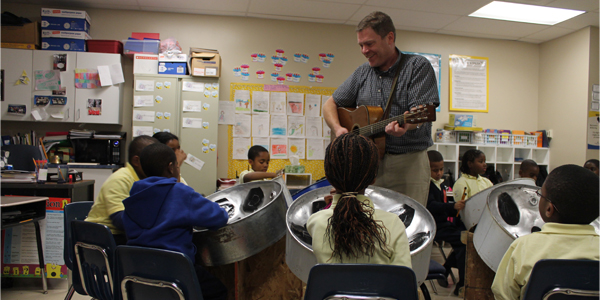
By Lindsay McLaughlin, Alternative Therapies Coordinator, The Pathways Schools
The Pathways Schools held its third annual Student Art Show on April 30. The event is a showcase for student creativity and artistic expression and is an opportunity to recognize standout partners, such as family members, Pathways staff and board members, businesses and agencies who employ or provide internships for our students, teaching artists who carry out residencies at our schools, and many others. This year’s Community Partner of the Year was Young Audiences teaching artist and musician Kevin Martin of Rockcreek Steel Drums for his dedication to bringing steel drum music and the vitality of Caribbean culture and history to our students.
During his residencies with students, Kevin teaches the basics of the steel drum, melody, rhythm, and so much more. Our students learned about another culture and saw a different way of seeing the world and themselves. Kevin has an ability to connect with students through music. That ability, along with his patience and consistent encouraging attitude, has made Kevin a sought-after teaching artist here at Pathways.
A couple years ago, our Pathways teachers and therapists were looking for ways to bring music into our schools so I asked Young Audiences staff to recommend a musician who could connect with our students. Thus Kevin came to us. He has completed no fewer than five residencies at Pathways in four of our six schools during the past two years. Next year, he is scheduled for a residency at a fifth school.
We are very grateful for Kevin, his commitment and talent, and also for organizations like Young Audiences that advocate for and make it possible for artists to come into our schools, work with our teachers and staff, and enhance the education and indeed the lives of our students and staff.
There’s a bigger picture here as well. As Pathways educators, we know that the best learning often doesn’t take place behind a desk. Our students thrive in a variety of learning environments, including museums and libraries, to job sites, such as ships sailing the Potomac tributaries and production studios at local television stations. Similarly, they learn best using a variety of means, like while playing a steel drum or molding a mosaic tile. This is because as human beings we need many avenues to take in the world and to release the prodigious power of our imaginations. This is what art does for us. It is an accessible way for us to connect our minds to the world that surrounds us. It gives us a way to communicate who we are–our ideas, thoughts, new understandings, and what we perceive
This is why it is critically important that we keep the arts vibrant in our schools for our students. How much better it is to experience the vitality of Caribbean culture through a steel drum compared to a textbook. How much better it is to feel the edges of a mosaic piece and use it to create an image with personal significance than look at a geometry chart or the dictionary entry for “symbol.” Art is how information becomes tangible and how knowledge becomes understanding. This is the sort of transformation that artists who come to work with our students facilitate every day. In turn, they are supported by dedicated arts educators and advocates who ensure that they are able to do what they do, particularly local and state arts councils and nonprofit organizations like Young Audiences.
Art–human expression in all its forms–should never be on the margins, whether we are talking about our communities or our schools. Thanks to the efforts of artists like Kevin and organizations like Young Audiences, it isn’t. Congratulations to the Pathways Community Partner of the Year Kevin Martin.
Learn more about Kevin and his program offering for schools.
Greetings from the staff of Summer Learning!
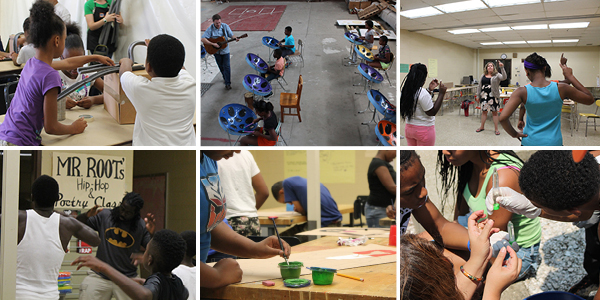
By Azya Maxton, 22nd Century Pioneers Arts-Based Summer Camp Arts Integration Facilitator
Summer Learning is off to a great start. Our sixth-graders are studying coordinate grids and the engineering process. Seventh- and eighth-graders are learning about run off in science and ratio in math. It’s so exciting to see them learning their math and science through arts integration and hands-on projects. Students have been designing roofs, buildings, and even cities! Last week, we got to explore the engineering process, and learn about science and industry during a field trip to the Baltimore Museum of Industry. Students were also given an opportunity to test water from the Chesapeake Bay for phosphates, dissolved oxygen, pH, and Chlorine. Today, students participating in arts enrichment classes will have the opportunity to present their work at Baltimore’s Artscape while students in robotics go on to a citywide competition!
We’ll continue to keep you posted on the wonderful learning of our middle school students throughout the next few weeks!
Read more about the arts-integrated learning happening at the Young Audiences 22nd Century Pioneers Arts-Based Summer Camp site and see photos here.
Students help raise funds to bring the arts to other schools
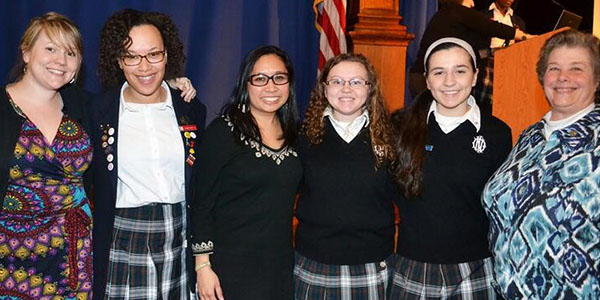
My name is Amanda Sessa and I am a student at the Institute of Notre Dame (IND) in Baltimore City. I am a member of the Shalom Club, a worldwide high school organization dedicated to peace. At IND, the Shalom Club partners with local charities to raise money for them.
For as long as I can remember my father, Thomas Sessa, has been on the board of Young Audiences/Arts for Learning. So, when the Shalom Club was looking to partner with a new organization, I automatically thought of Young Audiences. When I told the other members of Shalom Club about the work Young Audiences does to bring arts experiences to Maryland students, they jumped at the opportunity to partner with them because we believe that education is a gateway to peace in the world. Additionally, IND has focused on expanding its arts programs and its use of the arts to more fully develop the education of our students. Therefore Young Audiences was a perfect partner for IND and the Shalom Club.
On April 2, 2014, IND held a fundraiser called Bread and Soup Day organized by the Shalom Club. Prior to Bread and Soup Day, Young Audiences staff members Pat Cruz and Jess Porter (who is also an alumna of IND) came to our school to educate the students about Young Audiences and its mission. The response was overwhelming. On Bread and Soup Day we sold lunches to IND students and donated all of the proceeds (approximately $400) to Young Audiences.
I am very excited that I was able to connect IND with Young Audiences, especially because both organizations are dedicated to maximizing student achievement in Baltimore City and beyond. In addition to introducing Young Audiences to IND’s 400 students and its faculty, I learned a great deal about the role that Young Audiences plays in educating Maryland’s students, especially students of limited means.
I am lucky. I have always had an arts program in my school and assumed that all other students were also exposed to the arts. Pat and Jess showed me that many students–who often could most benefit from arts programs–do not have the chance to learn with the arts in school. I saw that my participation in middle school theatre performances and IND’s Choral Performance class should not be taken for granted. These experiences have been some of the greatest educational opportunities for me but are not available to thousands of students throughout Maryland.
My teachers have used the arts, including music and dance, in so many ways. I learned the alphabet through the ABC song, danced to a song warning me about talking to strangers, and continue to use music and song to recall words in Spanish. In English class this year my teacher had us act out the plays we read so we could see the events as the author intended. When we were not reading, she would have us draw pictures of settings, characters, and symbols to depict the text in a different way. The arts make learning fun and interesting and these were some of the best assignments I was given. It saddens me that they are not available to everyone.
The Shalom Club and the IND community hopes that our donation will help fund the important work of Young Audiences. We hope that our efforts will allow Young Audiences to reach students who otherwise would never experience the power of the arts educationally or in their lives outside of the classroom. I am proud to have been able to make a contribution to Young Audiences’ important work. I hope that IND and Young Audiences will continue to be partners for years to come.
Many thanks to Amanda Sessa and all the members of IND’s Shalom Club for their support of Young Audiences and increasing access to arts-in-education programs for all Maryland students!
Summer Learning begins
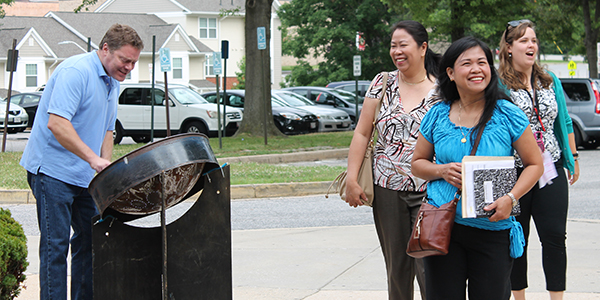
The school year may have ended, but for Young Audiences, that doesn’t mean the fun, arts-integrated learning stops. Young Audiences has again partnered with Baltimore City Public Schools to bring arts enrichment activities to seven Baltimore City 22nd Century Pioneers Arts-Based Summer Camp sites. In addition, for the first time Young Audiences is also managing an eighth completely arts-integrated camp site at Edmondson Westside High School. The 22nd Century Pioneers Summer Camp is free to Baltimore City Public Schools middle school students.
At the Young Audiences camp, nearly 150 students will explore math and science concepts through the arts in classes and arts enrichment activities led by Baltimore City teachers and Young Audiences artists during the five-week program. Students can select the art form they will focus on during enrichment sessions, with choices including dance, photography, illustration and mural painting, theatre, Hip Hop, steel drum, or VEX robotics.
Because this is the first-ever Young Audiences arts-based summer learning site, we thought it deserved an equally spectacular kick-off event. As students arrived, what better way to greet them than with the arts?
On Monday, June 30, as students walked up to the school for the opening day of camp, the first thing that hit their ears was the sound of a steel drum being played by Young Audiences roster artist Kevin Martin of Rockcreek Steel Drums. Kevin has been building and playing steel drums for more than 20 years; this summer, he will show students how the instrument connects to math.
See more photos from the Young Audiences arts-integrated summer learning site!
On the way into the building, students passed the dancing Valerie Branch, a new Young Audiences artist whose energetic moves caused many to stop and watch. Valerie will get students moving while studying science this summer. Those walking in also got to witness the Hip Hop talents of musician Jamaal “Mr. Root” Collier, who will use his skills to bring math to life. Bridget Cavaiola of Baltimore Improv Group used improvisational theatre techniques to direct students inside the building. With her help, students will learn how theatre can make abstract science concepts concrete.
The excitement wasn’t just at the front of the school. Once inside, students had the opportunity to take part in photographer Christina Delgado’s photo booth, dressing themselves in hats and glasses before striking poses. Students will have the chance to go behind the lens with Christina to learn the art of photography and its connections to math. Visual artist Danyett Tucker will link illustration to science. As students looked on, she created a colorful mural with images of various art forms incorporated into the design, from music notes to microphones to Polaroid pictures. Students were invited to create murals of their own, as each table was decked with markers and a giant sheet of paper.
All children, regardless of their resources or where they live, lose some math skills during the summer. Studies show that economically-disadvantaged students also lose literacy skills during this “summer learning slide.” Experts believe that the achievement gap between middle- and low-income students not only grows during the summer—it exists largely because of the summer.
Programs like 22nd Century Pioneers provide students with a safe place to go during the day, access to free healthy meals, adequate adult supervision, and positive, educational activities. This summer Young Audiences artists will connect students with new experiences through the arts as they learn about math and science in a new way and build their self-confidence as they gain knowledge and skills.
Check back in with the Young Audiences blog throughout July as we look at how these artist and teacher pairs are using arts integration in their classrooms.
Happy summer and happy learning!
New National Core Arts Standards launched
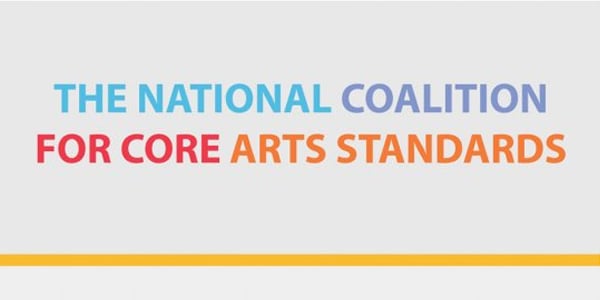
Last month, the National Coalition for Core Arts Standards introduced the new National Core Arts Standards. Developed through the collaboration of arts organizations, teaching artists, teachers, and practitioners, these standards aim to uphold the quality of teaching and learning.
Originally published in 1994, the National Core Arts Standards were the nation’s first guidelines for arts education. Since then, they have led arts education through growth in design, delivery, and assessment. Recent surveys, however, had shown that priorities of education policy as well as instructional resources and practices of arts educators have significantly changed since the standards’ initial publication, leading to a need for revision.
Thousands of artists, teachers, and arts educators, as well as three reviews from the public, helped to create the new National Core Arts Standards. We are proud to note that the Young Audiences Arts for Learning National Office played a significant role in writing the standards. Young Audiences also managed the creation of the new standards’ website.
After two years of development, the new standards and website were officially launched on June 4. While the newly implemented standards were closely built off of those published 20 years ago, they also show significant growth. The revision includes an emphasis on communication and collaboration, two 21st Century Skills now stressed by higher education and employers.
The new Core Arts Standards also supplement the original four artistic disciplines of dance, music, theatre, and visual arts with a fifth: media arts. This encompasses such mediums as film, animation, and gaming or interactive- and computer-based art making. The new standards also support the development of artistic literacy by encouraging students to independently take part in four artistic processes: creating, performing/producing/presenting, responding, and connecting. These processes can be seen in the 11 Anchor Standards that are common across all five art forms.
Questions about the new standards? Visit Young Audiences’ National Core Arts Standards FAQ.
Students share knowledge of biomes with creative songs

The following is reposted content from Young Audiences roster musician Alden Phelps’ blog.
Westbrook Elementary School shines again!
I again visited the school for a Preposterous Parodies residency program. This year’s songs focused on different biomes: desert, grassland, ocean, rainforest, tundra, and forest. Each class tackled two of them.
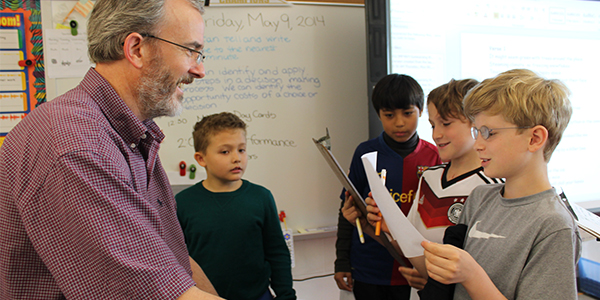
See more photos from this residency here!
Once again the creative students at Westbrook Elementary have written some great parodies of recent hits. Great work, and many thanks to the fantastic teachers, parents, and administration, who made this residency such a pleasure to do! Below is just one example of a song written by the students. Click here to see the lyrics to all the parodies.
Desert (parody of “Treasure” by Bruno Mars)
Verse 1:
Really hot, burning hot, scorching hot in the desert
Dying for icy cold water in these places
Coyotes and gila monsters you could get so hurt
But you’re fainting out here so you want to find an oasis
Pre-chorus 1:
I’m dy-y-ing
I know that I’m complaining but it’s hot out here (hot out here)
I’m dy-y-ing
A scorpion just stung me now and I got tears (I got tears)
Chorus 1:
Desert, you may not survive
It’s so hot there you could die
There are barely any trees
I need some water please
The wolves are after me, me, me
Verse 2:
Grassland, grassland, grassland it’s so green here
I look around and I see no waving trees
Once in a while, there’s a flaming fire
I’m freaking out it is going past my knees
Pre-chorus 2:
Oh graaaaass lands
I know you’re unaware that cheetahs hunt their prey (everyday)
Oh graaaaass lands
Boy I’m gonna show you how it’s cold all night (hot all day)
Chorus 2:
Grasslands, that is where we are
The grass is huge and tall
Wildebeests graze on their cuisine
African plains are clearly seen
The lions get a lot of pro-tein, tein
Bridge:
A spiny cactus, it’s in the desert
If there’s a sandstorm you’d better close your eyes
The grass is so tall, that you should measure
The bobcats stalk here, they paw at butterflies
Chorus 3:
Treasures, that’s what these places are
Finding water’s just too hard
Hottest and flattest lands I’ve seen
They are mostly brown and green
The conditions are hard and mean oh oh
Read more posts by Alden on his blog. Learn more about Alden’s programs for schools offered through Young Audiences.
More than Movement
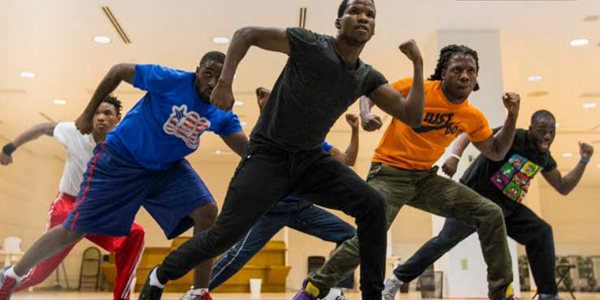
Illstyle and Peace Productions, a Young Audiences roster ensemble, is a multicultural dance company that delivers a positive message of individual expression. They’ve performed for audiences young and old across the world. Last year, they were chosen by the U.S. State Department’s DanceMotion USA program as cultural ambassadors in Belarus, Russia, and the Ukraine. No matter where they perform, their work focuses on a specific theme: the spirit and movement of Hip Hop.
The spring edition of Philadelphia’s JUMP, a magazine that promotes the city’s music scene, featured an interview with this talented group. In the article, Illstyle and Peace Productions discuss what movement means to them.
“Movement can make a difference,” said founder and artistic director Brandon “Peace” Albright. “Movement can make a change. Movement can make a career out of somebody. Movement can bring forth peace, love, and respect for everyone.”
The article also praises Albright for his high-energy workshops and educational programs, such as No Bullying, STOP Bullying: Let’s Be Friends, an assembly that teaches positivity, fairness, working together, acceptance, and communication, and The History of Hip Hop, which brings the history of Hip Hop dance to life. Both programs are offered through Young Audiences.
Read the full JUMP article on page 27 here.
Learn more about Illstyle and Peace Productions and their assembly programs for schools here.
Students re-envision their neighborhood through illustration
By Danyett Tucker, Young Audiences illustrator and Artist Associate
During my recent mural residency program at Hamilton Elementary/Middle, students celebrated their community by remodeling Main Street and adding their own businesses. Social awareness symbols are sprinkled throughout their fantasy blueprint which now proudly covers their lunchroom wall.
I began by taking photos of well-known businesses in the area so that students could work on designs to upgrade their neighborhood. They decided what businesses they would like to add and represented those with related symbols. In class, we listened to a socially-conscious soundtrack and used some of the lyrics as inspiration to include messages that would uplift the community.
The students created all of the drawings and then I collaged their individual efforts together to create the scene. Together, we painted for days on end! During the course of six more workshops with me, and several additional sessions led by my teacher partner Ms. Friedman, this mural came to life. The sixth, seventh, and eighth grade art classes all contributed to the piece.
Ms. Friedman worked tirelessly on the mural panels outside of our workshops in the classroom. Since Ms. Friedman is retiring at the end of this school year, we included a student drawing of her in the finished mural.
Click here to see the full mural and see if you can spot Ms. Friedman!
Ms. Friedman’s first name is Charlotte, like in “Charlotte’s Web,” so look for the spider web as a clue to where she is located.
Ms. Freidman shared: “I love, love, love the mural! Everywhere I look, I see something new! Students and parents went down to see the finished piece after a recent school concert and the building’s custodians finally had to chase them out because they were so caught up in it.”
It was an awesome experience!
This residency was made possible through a Maryland State Arts Council Arts in Education Artist-in-Residence Grant. Learn more about how Young Audiences can assist your school or community organization in applying for this and other grant funding opportunities online.
Learn more about this residency program and Danyett Tucker’s other program offerings.
Keeping the art of screen painting alive with Baltimore students
By John Iampieri, Young Audiences visual artist and screen painter
There is a magical feeling that happens when you are painting a screen. Everywhere I go, I always ask, “Has anybody ever seen a painted screen?” and hardly anyone ever raises a hand. It is such a functional, unique art form, and yet there are only a handful of us left that are associated with the Baltimore Painted Screen Society. Screen painting is like any other practice or custom that becomes extinct: it can become too late to embrace it.
I make it my mission to try to keep the art alive by sharing my passion with others. When I’m working with students during a screen painting residency program, I’m planting the seeds of knowledge about an art form specific to Baltimore. This is why the opportunity to bring a residency to Baltimore Design School students was so exciting for me.
There are so many talented young people at the Baltimore Design School. Early on in the residency, I realized that I was working with a special group of individuals with a lot of possibilities ahead of them. The task at hand was to work with an unusual art form that was born and bred in Baltimore, and the students rose to the occasion.
I had the opportunity to collaborate with the teachers before our first workshop to create the curriculum that would work best for students. We decided to focus the designs of the screens on four categories: fashion design, architecture, graphic design, and visual arts. The students went online to research artists in three of these fields, and then voted on the artists they wanted to feature. Students sketched designs of the three selected individuals which would be transferred to the screens. The teachers also got involved, collaborating with me to create the design for the fourth and final screen, featuring visual artist Romare Bearden.
During the residency, students had the opportunity to meet with folklorist and author Elaine Eff for a tour through her exhibit, “Picture Windows: The Painted Screens of Baltimore and Beyond,” at MICA in January. Throughout the tour, the students were interested and focused, and they got a great experience out of it.
In the classroom, my goal is always to keep the kids engaged. One way I do this is by giving control to the students. I brought the materials, but the students constructed the frames and stretched the screens. I constantly reminded them after each workshop, “Remember when we started this project? There was nothing! Remember when the screens were black? Remember when we primed them? Remember when we painted?” I wanted to reiterate to them that everything was their doing.
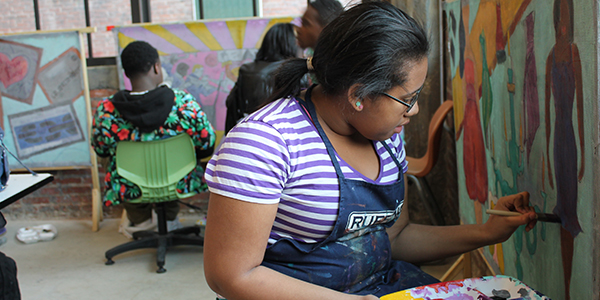
See more photos from this residency here!
Teacher Ms. Cafaro developed the idea of a screen painting quiz. Working together, we made a list of questions on screen painting, incorporating what students had learned in class about the history of the art form, the figures they were painting, and other famous historical designers. This exercise regularly grounded our project in history, connecting the construction of the screens to what was being learned in the classroom.
What was most challenging for the students during the residency was working in groups. Creating painted screens in the classroom is really team-oriented, and each workshop is an organized chaos as students work next to each other and make decisions together. After collaborating on the design of the screen, decisions also need to be made about color and the application of the paint.
It’s very exciting to see those types of engagements among students. When everybody–students and teachers–saw the completed screens, they genuinely reacted with “Wow, these are really cool!” I encouraged the students to try screen painting at home now that they are trained professionals.
Projects like this residency are important because through the arts, students can learn a different way to better understand curricular concepts that may be more challenging when taught with a more conventional learning path.
I’m very fortunate to be able to get into the classroom, and I never could have done it if it weren’t for what I’ve learned through Young Audiences and the Maryland State Arts Council. I’m fortunate to be involved with Young Audiences because it gives me the chance to do what I love.
Read Elaine Eff’s reflection on the residency.
Learn more about John Iampieri and his visual arts residency program.
In Memoriam: Beth Braden
By Jason A. Dykstra, Director of Accountability & Testing, Instructional Data Division, Anne Arundel County Public Schools, and Former Principal of Southern Middle School
On April 30, 2014, Beth Braden, an outstanding educator, champion of arts integration, mentor to teaching artists, and great friend to Young Audiences, passed away. Thank you, Beth, for your passion, energy, and commitment to providing an arts-rich education to all students. Your legacy will continue through the many teachers, artists, and students you have influenced. You will be greatly missed.
“Hi Boss!” That was the typical greeting I would get at any given moment by Beth Braden during my five years as principal of Southern Middle School. She would have a smile on her face, a spring in her step, and she would simply move on with whatever she was busy doing at the time. That greeting, as it turned out, was more than a “Hi.” It was a sign of confidence that we are going to have a good day—that we are getting the job done—and that we are making a difference today. All in that one little phrase: “Hi Boss.” I think it was the way she said it that made me understand.
Of course, I am not sure that I realized that until after I had been working with Ms. Braden for a year and learned how special she was. For those who have had the amazing pleasure of working with Ms. Braden, we saw first-hand her passion for teaching, her love of students, and her dedication to making a difference every day. It would be unforgivable to forget her unwavering advocacy of arts integration. It was actually hard to have a conversation with Ms. Braden where she would not find a way to mention how the arts could help students. Even discussing eighth grade discipline referrals, she would remind us that more exposure to the arts would help those students. That’s it—we need more assemblies and experiences!
How do we possibly measure Ms. Braden’s contributions and importance to Southern Middle? Not only can it not be measured, her influence will live on at Southern Middle School for years to come. Her school spirit and commitment to the cultural arts will be remembered by all. Did I really have a choice but to agree to a slam poetry assembly? Ms. Braden reassured me that not only would the assembly go well, but our students would really benefit from the experience. It was no surprise that she was right on both points.
We all have very special memories with Beth Braden—whether it is amazing improv performances by the Drama Club & Zip Zap Zop, steel drums, African dance, field trips, dressing up for spirit days and Halloween, celebrating Dr. Seuss’ birthday and Emily Dickinson, lively classroom debates, Artful Thinking activities, cool projects, and, most importantly, seeing all of the arts showcased at the largest and best cultural arts event at the middle school level—The Arts Are Everywhere Gala. Those traditions will no doubt continue and we can thank Beth Braden for teaching us the value of the arts and how new and different experiences enhance our lives.
What makes Beth Braden truly special and unique, however, was her work in the classroom. Every day was 100%. Every day was an opportunity to reach a student. Every day was a chance to make a connection. Every day was designed to be a success. The result? Every day was the epitome of trying to make a difference. At times it could seem unconventional, but she never lost hope and was always willing to give a student another chance to be successful and they respected Ms. Braden for it. The biggest compliment I could possibly give is that I would have loved for both of my children to have had Beth Braden as their teacher. The great news is that thousands of students did have the opportunity to benefit from her passion, creativity, knowledge, and many talents. In addition, we got to work side-by-side with a fantastic educator. We were all very fortunate and we know it!
Both in and out of the classroom, Ms. Braden really just wanted her students to think outside of their box, to explore themselves through reading, writing, and the arts, and to communicate well-thought-out ideas and opinions. What would Ms. Braden want from us today? For us to think out of the box about the potential of our amazing profession, to explore more ways to create positive change in school, and to communicate all of our great ideas and opinions with each other. That is an easy and wonderful way to honor Beth Braden and her many contributions to education and our lives.
Sometimes we don’t have to say much to make a difference in a person’s life—“Hi Boss”—it was just the way she said it that made me understand. So thanks to you Ms. Braden—we are going to have many good days, we are going to get the job done, and there is no doubt that we are going to make a difference! “You Rock!”
Watch a short video that features Beth explaining why the arts are critical in every classroom.
Working to bring the arts to every student
By Dr. Sherrie Norwitz, Instrumental String Music Teacher, Thomas Jefferson Elementary Middle
Art and aesthetics are crucial to the foundation of society. Arts education provides children the opportunity to be exposed to–and develop their own–appreciation of beauty in their world. Art is a way to transmit the values of the society. Through the arts, children learn about their community, helping to provide them with a context for their lives within their communities, and become active participants in helping to create their communities. Arts experiences open doors to children, allowing them to say, “I am touched by this. I am a part of this beauty. I created this. I shared my creation. This has meaning to me.”
Sequential education in the arts is a crucial component in a child’s education. Learning about and through the arts gives students ownership of skills and knowledge to become active participants in society through creative expression and communication.
It is important to me for students to experience the integration of the arts across the curriculum and the varying natural connections that are inherent between the arts and their core curriculum subjects. This arts integration approach supports the learning of core curriculum subjects, reaches a wide-range of learners, provides authentic real world experiences that directly involve students in the act of creating, provides opportunities for collaboration, and supports the development of 21st Century Skills through the Common Core and Career Ready Standards.
Through our partnerships with Arts Every Day and Young Audiences, our school community is finding its way in creating a comprehensive arts integration program. With the support of our principal, Ms. Henry, we feel that we have a very strong foundation for our program’s growth and development.
This year we began by extending the arts-integrated approach to learning beyond the artist-in-residence program which we had previously brought to our students. Working with Young Audiences, we created a Resident Teaching Artist position for the year to allow for the continued presence of a teaching artist within our school. Our Resident Teaching Artist, Young Audiences artist Kwame Opare, performed with his ensemble, DishiBem G.R.O.W. during school-wide assemblies, and provided workshops to fifth- through eighth-grade students. Kwame also provided our teachers professional development in arts integration to help answer their questions, provide guidance, calm apprehensions, and worked with teachers during collaborative teaching days to bring arts integration directly to the students in their classrooms.
Partnering with Young Audiences to provide such a variety of programs throughout the year ensured that we incorporated arts integration best practices and included all of our grade levels–preschool to grade 8–in these art experiences. Being an International Baccalaureate School (IB) also helped support our way forward in the interdisciplinary learning of arts integration.
Arts integration and arts-enhanced learning is happening in many ways in different classes. Among our activities, students have drawn Grecian vases as part of their Ancient Civilizations unit, they have dramatized stories through dance, applied music notation to learning fractions, used music to help understand number columns, made connections between literature and music while dancing “The Nutcracker,” and created a paper Freedom Quilt.
We have developed a rhythm of arts integration at Thomas Jefferson. We are working to create an environment where everywhere you look, the arts are happening, where the arts are for everyone at the school and where connections with the arts can be made throughout a student’s day. Having a sense of continuity of arts experiences helps create a feeling of expectation of such experiences for both students and teachers. There is a developing sense school-wide that the arts and arts integration “is what we do.” We look to have the arts not as “special” but as a continuing presence in our daily school life, where learning can take place through the arts. There is something for everyone–for students in all grades covering a variety of subjects, and for teachers to feel supported with our teaching artists and our partnerships with Arts Every Day and Young Audiences.
Artistic energy invigorates the school environment, developing our professional skills as teachers and invigorating learning for students.
The Intersection of Art and Science

Young Audiences’ artist roster includes professional teaching artists who are both highly skilled in their art form and passionate about engaging students in learning through their art. Our artists are experts at highlighting the natural connections between their art and the curriculum, including everything from world history to math to literature. Every Young Audiences program both shares skills specific to dance, music, theatre, or visual arts and offers students the opportunity to learn about other curricular subjects in a new way.
For Young Audiences artist Kevin Martin, art links directly to science. Kevin is an artist who specializes in building and playing the steel drum, an instrument that requires a vast amount of scientific knowledge in its production. Kevin was recently interviewed in Trumpf Express, a magazine dedicated to sheet metal processing, for his scientific expertise. In the article, Kevin points to studying the carbon content and thickness of the metal as well as balancing strength and flexibility as some of the essential aspects of creating a drum.
Kevin brings steel drum music into schools through assembly performances and hands-on workshops with students and educators. During residency programs like the Steel Drum Experience and professional development programs for educators, such as Steel Drums in the Classroom and The Physics of Steel Drums, Kevin brings dozens of steel drums into the classroom so students and teachers can try their hand at playing the instrument and experience how physics concepts play a role in the sound of the drum. As Trumpf Express notes, “last year, he visited 100 schools with up to 100 students at a time, and thanks [Young Audiences], Kevin is able to provide many with drums of their own.”
Though Kevin is accomplished in both the science side of production and the artistic side of playing, when asked what he loves to do most, Kevin responded, “I love all of it.”
Read the full article by clicking on the image below.
Watch Kevin speak about his passion for steel drums at TEDxChesterRiver here.












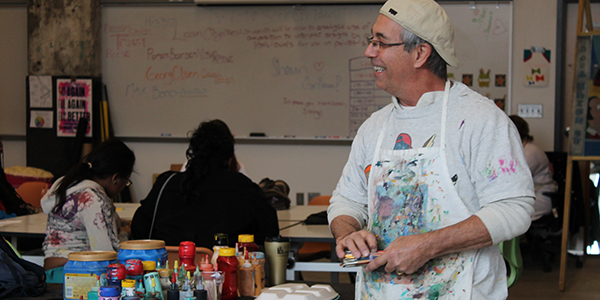

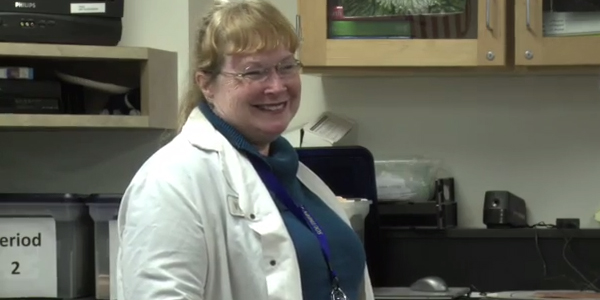


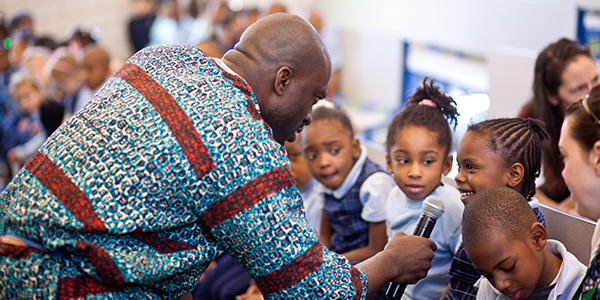
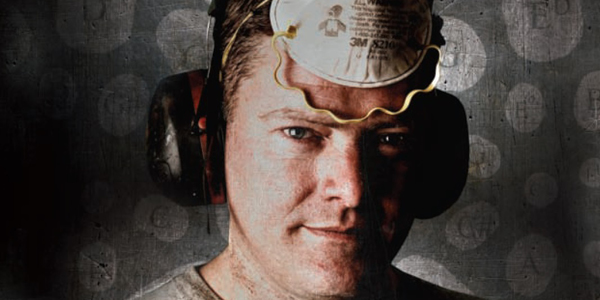
![KM2[1]](http://youngaudiencesmd.files.wordpress.com/2014/05/km21.jpg?w=235)